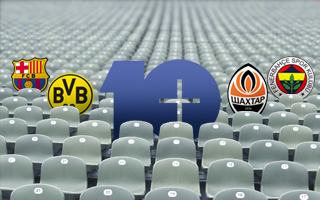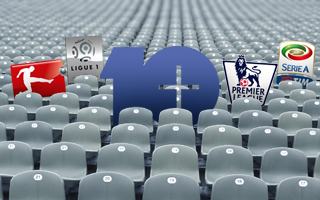Riverside Stadium
| Capacity | 34 742 |
|---|---|
| Country | England |
| City | Middlesbrough |
| Clubs | Middlesbrough FC |
| Other names | Cellnet Riverside Stadium (1995-2002) |
| Inauguration | 26/08/1995 (Middlesbrough - Chelsea, 2-0) |
| Construction | 1994–1995 |
| Renovations | 1998, 2016 |
| Cost | £ 16 million (1995), £ 5 million (1998), £ 5 million (2016) |
| Record attendance | 35,000 (England - Slovakia, 11/03/2003) |
| Design | The Miller Partnership |
| Contractor | Taylor Woodrow Construction |
| Structural Engineer | Ove Arup |
| Address | Middlehaven Way, Middlesbrough TS3 6RS, United Kingdom |
Advertisement
Riverside Stadium – stadium description
Riverside Stadium was built in the post-Taylor-Report era, released as crucial new stadium safety guidelines in the aftermath of the Hillsborough disaster. The document outlined measures to be implemented, primarily installation of individual seats, which prompted mass conversions and expansions to meet ticket demand. With the redevelopment of century-old Ayresome Park considered unviable, Middlesbrough FC decided to relocate to a new ground.
Where did Middlesbrough play before Riverside Stadium?
Middlesbrough FC spent almost all of the 20th century at Ayresome Park, built back in mid-1903. The ground stood roughly 2.4 km (1.5 miles) south-west of the Riverside, in a housing area. This meant it wasn't possible to expand sufficiently in the post-Taylor era, beyond its closing capacity of 26,667 people. Once the club stopped using it even for training purposes, Ayresome Park was demolished in 1997 and replaced by housing.
Where is Riverside Stadium?
Geographically closer to the city's centre, the new stadium was located in an industrial area, within the largely vacant Tees docks. The deteriorated site was offered by the Teesside Development Corporation and approved by the local council. Construction began in fall of 1994 and took impressively little time, less than 9 months. Opening game against Chelsea drew over 28,000 people, which was already the highest turnout in 14 years. Demand proved high enough to prompt expansion just 3 years into the stadium's existence. Addition of corner sections brought the capacity up to roughly 35,000.
Who owns Riverside Stadium?
While the land and necessary approvals required cooperation from both public and private entities, the stadium is owned privately by Middlesbrough FC, who also financed construction of Riverside Stadium. However, the project – being the largest new stadium opened in England post WWII – also utilised public funding for anciliary infrastructure, primarily the road network.
When was Riverside Stadium modernised?
Although the first expansion took place just 3 years after opening, in 1998, corner stands offered the same standard as the initial construction. It wasn't until 2016's return to Premier League that the stadium proved somewhat aged, following over 20 years in operation.
The stadium received a brand new LED floodlighting system, a new press section with improved working area for journalists, as well as wheelchair platforms to match growing push for accessibility of English stadia. The hospitality facilities were also upgraded, while the south stand received two new TV studios.
The north stand, along the Teesside, is referred to by fans as the New Holgate End, in honour of the famous terrace at Ayresome Park, where generations of supporters used to stand. The west side is by far the largest in terms of volume, not only comprising bulk of matchday facilities but also offering two tiers of seating rather than one.
Riverside Stadium hasn't only been home to Middlesbrough FC games but also internationals. During reconstruction of Wembley, for example, the national team played here against Slovakia before Euro 2004, setting the stadium's attendance record.
How Riverside Stadium compares to other Championship venues?
Advertisement
Pictures
-

21.03.2016 © Bradford Timeline 
30.11.2014 © Mike.Dales 
28.02.2016 © David Robinson 
07.05.2015 © julia eckley /alan hooper 
02.10.2015 © David Warburton 
20.04.2015 © David Warburton 
03.04.2014 © sbally. 
08.07.2016 © yogi59 
04.06.2014 © yogi59 
04.06.2014 © yogi59 
13.09.2017 © Mark Lee 
14.09.2017 © Mark Lee 
14.09.2017 © Mark Lee 
14.09.2017 © Mark Lee 
14.09.2017 © Mark Lee 
14.09.2017 © Mark Lee 
14.09.2017 © Mark Lee 
03.08.2013 © Darren Blades 
23.04.2016 © Mike.Dales 
15.05.2015 © Darren Blades 
19.04.2014 © Bob Jewers 
19.04.2014 © Kevin Harrington
Related news
2025
2024
2021
2020
-

COVID-19 crisis: English supporters to return in October?
The government is preparing to reopen sports stadiums across the UK. While first trial events will take place in just 2 weeks, all stadiums could be open again only from October onwards.
-

England: 341 games in five “regional hubs”?
In case not all stadiums are available to host games of Championship, League One and League Two, the EFL is considering using stadium clusters to hold the 341 remaining league games of 2019/20.
-

England: Safe standing in Premier League and Championship from 2021?
Though physically safe standing is already in Premier League, legally it's still prohibited. But that might change as the government is expected to act quickly, possibly introducing legal standing in 2021.
2018
-

Safe standing: Government to rethink all-seating
By all means the debate was predictable, but that's fine, we'll take it. The most important thing is: British authorities will review the all-seater rule, which officially opens the case for legal standing in top leagues of England and Wales.
-

England: Supporters force parliament to debate safe standing!
It took only several days of momentum to reach immense support of 100,000 British citizens and thus force the British government to officially debate safe standing in Premier League and Championship.
2016
-

England: Away fans must be placed pitch-side
From the 2017/18 Premier League season no club will be allowed to place away supporters far from the field. At least one section has to be placed just behind the field.
-

10+ Ranking: Europe’s most popular clubs by attendance
We’ve listed all 227 clubs that draw an average of 10,000 people or more every day. Which teams from your country are on the list?
-

England: Boro stadium upgrade to cost £5 million after promotion
Middlesbrough are returning to the Premier League after 7 seasons in exile and their stadium proves outdated enough to require investment. But it’s nothing compared to what they’ll earn.
2015
-

10+ Ranking 2015: Attendances in Europe (Part 2. The Clubs)
Borussia, Barca and Man United – lovely dominant trio. But it wasn’t them who gained most fans last season. Check all 217 clubs that draw an average crowd of 10,000+!
-

10+ Ranking 2015: Attendances in Europe (Part 1. The Leagues)
Numbers don’t lie: French Ligue 1 outgrew Italian Serie A as Europe’s fourth largest league. Premier League seems unlikely to catch up to Bundesliga, while Turkey, Ukraine and Scotland are down.
2014
2012
-

England: Ticket prices breaking new records
And not the kind of records supporters would wish to see. First time ever average price for the cheapest seats in top four leagues (!) exceeded £20. That means ticket prices in England are rising at 4 times the speed of inflation – BBC Sport alarms.
-

England: Visiting 116 stadiums on a bike, scoot or on feet
He’s neither an away-going supporter, nor a groundhopper. It’s also not a sports discipline, what he’s doing. Steven simply decided to visit 116 venues in England and Wales using his bike, scoot and feet. This is how Football Ground Tour was born.
 StadiumDB
StadiumDB


